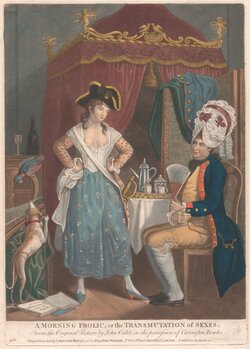See, The Merchant of Venice, Cymbeline, Twelfth Night and As You Like It, as well as Spenser's Faerie Queene; for later works, see Jane Eyre, Huckleberry Finn, War and Peace, The Scarlet Pimpernel, The Wind in the Willows, and The Lord of the Rings - all have characters disguising or attempting to disguise themselves as the other sex. Even Achilles in Greek myth went undercover as a woman (and that's not the lone Greek example), and Norse and Hindu mythology also have cross-dressing characters (in both directions). And of course in performances of plays and opera, at different points in history due to the nature of the role, sometimes men played women or women played boys (the latter called
travesti, or breeches; in
Fidelio and
Figaro, it's a plot point).
There is a ton out there about crossdressing in life and literature from (in the West) the Middle Ages forward. Sticking to the Jane Austen era and before (Austen bridged 18th-19th c.), I found this, which focuses on the 18th c.:
https://www.amazon.com/Sapphic-Cros...?dplnkId=fb099ca5-40bb-4641-bd67-4eca3f5e5192
Is it good or compelling? No idea, but it's a book.
And I can't vouch for the scholarship in this article, but it seems largely consistent with others I've seen:
https://www.lovetoknow.com/life/style/cross-dressing
In real life, some notable women authors going back hundreds of years have dressed "as men" (much of which is standard clothing for women today):
To pick one near contemporary of Jane Austen (1775 - 1817), George Sand (1804 - 1876) was known for dressing as a man (and smoking cigars): "Victor Hugo said of her: “George Sand cannot determine whether she is male or female. I entertain a high regard for all my colleagues, but it is not my place to decide whether she is my sister or my brother.” (Cited in
George Sand: A Biography of the First Modern, Liberated Woman by Samuel Edwards, 1972)."
There were also molly houses in 17th/18th c. England, which were gay houses and included cross-dressers - and while the results of arrest after a raid were
dire consequences, they certainly did exist.

(both male and female in various stages of crossdressing; c. 1780, per the Yale Museum of British Art)
One last description of a molly house scene:
"One account delivered in the court known as the Old Bailey [...]: “Some were completely rigged in gowns, petticoats, headcloths, fine laced shoes, befurbelowed scarves, and masks; some had riding hoods, some were dressed like milkmaids, others like shepherdesses with green hats, waistcoats, and petticoats; and others had their faces patched and painted and wore very extensive hoop petticoats, which had been very lately introduced.” In a slew of costumes and colors, they danced, drank, and made merry."
(this^ article has a lot of contemporary account-based descriptions of molly houses, including some apparent activity involving dressing as women, calling each other "sister," and pantomiming childbirth...)

 or
or
